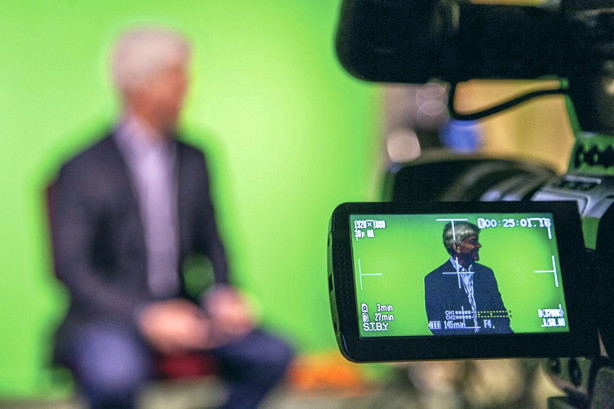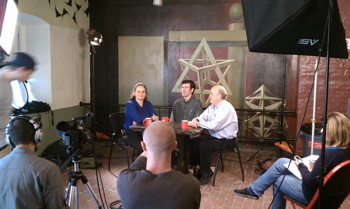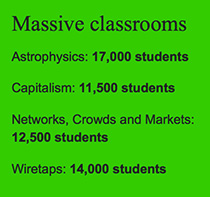Online Learning
The world as our classroom: MOOCs foster a global student body

Faculty member being videotaped for a Cornell MOOC. Photo: Barbara Friedman.
For 55,907 global villagers sitting in online Cornell classrooms, the sage Marshall McLuhan's idea of a shrinking world in an electronic age is reality. Any person, anywhere, in any corner of the Earth may become a virtual Cornellian - for free - from the comfort of home.
This spring Cornell introduced four MOOCs - massive open online courses - that feature unlimited student participation and are open to anyone. Cornell offered MOOCs on relativity and astrophysics, wiretaps and surveillance, networks and crowds, and a history of American capitalism. In spring 2015, the university will offer four more MOOCS on smartphone computer systems, global hospitality management, civic ecology and a philosophy course, The Ethics of Eating.
In addition to providing worldwide access to Cornell's academic excellence and adding value to teaching and learning on campus, "MOOCs also have promotional value for participating colleges and universities," wrote Cornell President David Skorton and Glenn Altschuler, dean of continuing education and summer sessions, in a 2013 Forbes magazine blog. "It's one thing to brag on a website about brilliant faculty. It's another when tens of thousands of people experience their brilliance firsthand, with the college's name attached." Cornell faculty being videotaped for a Cornell MOOC. Photo: eCornell. See larger image Similar to in-person classes, the professors who teach Cornell MOOCs prepare a course syllabus, record short weekly lectures, assign reading and homework, require written essays, give quizzes and provide close to real-time discussions on the edX website. While no course credit can be received, the students may earn Ð for free Ð a certificate of completion. With ample registrants from the United States, the classes enroll nonnative English speaking students from Europe, Asia, Africa and South America, who may be farmers, lawyers, nurses, scientists, factory workers and high school students. Louis Hyman, assistant professor in the ILR School and an economic historian, estimates that he spent about 250 hours preparing his MOOC with Ed Baptist, professor of history, with whom he co-taught the capitalism course. "I spent a lot of time on my video lectures, which means compressing my ideas and synthesizing my remarks into five- to eight-minute segments," Hyman says. "I had to stick to the main point of my lectures, which I think has improved the clarity of my teaching in the classroom." Students even politely debate the very meaning of capitalism. "I view capitalism as a system that involves somewhat of an economic survival of the fittest atmosphere, one that relies on free market and free trade to drive the economy," suggested one online student. "It can be defined by a clear system of a varied economy, with several different entities producing the same product that start market competition." Lighthearted humor snuck into sometimes weighty discussions. Capitalism students opined in Haiku: "We buy and we sell/Futures of commodities/The way of the Dow." In Steve Wicker's wiretaps MOOC, his readings ranged from his own text on "Cellular Convergence and the Death of Privacy" (Oxford, 2013) and "A Brief History of Wi-Fi," (The Economist, 2004) to "The Right to Privacy," by Samuel Warren and Louis Brandeis (Harvard Law Review, 1890). Wicker, professor of electrical and computer engineering, was impressed by the students' desire to learn. For his class, about 14,000 students registered and about 800 will earn certificates, a completion rate on par with other major university MOOCs.
For the MOOC "Networks, Crowds and Markets," professors ƒva Tardos (computer science), David Easley (chair, economics) and Jon Kleinberg (computer science, information science) enrolled more than 12,500 who wanted to know how social, economic and technological realms intertwined. Student registration exceeded 17,000 in astronomy professor David Chernoff's astrophysics MOOC, a stimulating introduction to relativity. They explored photons, paradox, pulsars and the infinite speed of the universe. Students faced real equations for concepts like gravity (G = 6.67 10 8cm3 s 2 g 1), parsecs (1 pc = 3.086 1018 cm) and astronomical units (1AU = 1.496 1013 cm). More than 2,700 students in the astrophysics MOOC completed at least one homework assignment and over 700 earned a course certificate. At semester's end, the students cheered themselves in the online discussion groups whenever one earned a certificate. With the rising popularity of MOOCs, the recent Report of the Cornell Distance Learning Committee (March 2014), chaired by Laura Brown, senior vice provost for undergraduate education, encourages creative distance-learning trials, noting that these investments also benefit on-campus teaching. For Wicker, the most surprising aspect of teaching a MOOC: "We really can reach out effectively to tens of thousands of students."

More information:
www.edx.org/school/cornellx
www.cornell.edu
www.cornell.edu/academics/continuing.cfm
www.cornell.edu/video/channel/cybertower